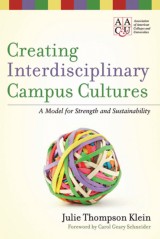Details

Creating Interdisciplinary Campus Cultures
A Model for Strength and Sustainability1. Aufl.
|
36,99 € |
|
| Verlag: | Wiley |
| Format: | |
| Veröffentl.: | 15.12.2009 |
| ISBN/EAN: | 9780470573136 |
| Sprache: | englisch |
| Anzahl Seiten: | 240 |
DRM-geschütztes eBook, Sie benötigen z.B. Adobe Digital Editions und eine Adobe ID zum Lesen.
Beschreibungen
<p>Praise for Creating Interdisciplinary Campus Cultures</p> <p>"Klein's analysis shows convincingly that from research in the sciences to new graduate-level programs and departments, to new designs for general education, interdisciplinarity is now prevalent throughout American colleges and universities. . . . Klein documents trends, traces historical patterns and precedents, and provides practical advice. Going directly to the heart of our institutional realities, she focuses attention on some of the more challenging aspects of bringing together ambitious goals for interdisciplinary vitality with institutional, budgetary, and governance systems. A singular strength of this book, then, is the practical advice it provides about such nitty-gritty issues as program review, faculty development, tenure and promotion, hiring, and the political economy of interdisciplinarity. . . . We know that readers everywhere will find [this book] simultaneously richly illuminating and intensively useful."<br /> —from the foreword by Carol Geary Schneider, president, Association of American Colleges and Universities</p> <p>"Klein reveals how universities can move beyond glib rhetoric about being interdisciplinary toward pervasive full interdisciplinarity. Institutions that heed her call for restructured intellectual environments are most likely to thrive in the new millennium."<br /> —William H. Newell, professor, Interdisciplinary Studies, Miami University, and executive director, Association for Integrative Studies</p> <p>"In true interdisciplinary fashion, Julie Klein integrates a tremendous amount of material into this book to tell the story of interdisciplinarity across the sciences, social sciences, and humanities. And she does so both from the theoretical perspective of 'understanding' interdisciplinarity and from the practical vantage of 'doing' interdisciplinarity. This book is a must-read for faculty and administrators thinking about how to maximize the opportunities and minimize the challenges of interdisciplinary programming on their campuses."<br /> —Diana Rhoten, director, Knowledge Institutions Program, and director, Digital Media and Learning Project, Social Science Research Counsel</p>
<p>The Author xi</p> <p>Foreword xiii</p> <p>Acknowledgments xix</p> <p>Introduction: A Model for Interdisciplinary Change 1</p> <p>1 Mapping National Drivers of Interdisciplinary Change 15</p> <p>2 Bridging National and Local Maps 37</p> <p>3 Platforming Interdisciplinarity 67</p> <p>4 Fostering Programmatic Strength and Sustainability 99</p> <p>5 Monitoring the Interdisciplinary Career Life Cycle 127</p> <p>Conclusion: Countering Myths and Situating Practices 153</p> <p>Resources 161</p> <p>Glossary for a Core Vocabulary 181</p> <p>References 183</p> <p>Index 199</p>
<p><b>Julie Thompson Klein</b> is a professor of humanities in English and interdisciplinary studies at Wayne State University in Detroit, Michigan. She is past president of the Association for Integrative Studies (AIS) and former editor of the AIS journal, Issues in Integrative Studies. Klein consults widely both nationally and internationally and is the author and editor of many books, including Interdisciplinarity: History, Theory, and Practice; Crossing Boundaries; and Humanities, Culture, and Interdisciplinarity. She is also associate editor of the forthcoming Oxford Handbook on Interdisciplinarity.</p> <p>The Association of American Colleges and Universities (AAC&U), headquartered in Washington, D.C., is the leading national association concerned with the quality, vitality, and public standing of undergraduate liberal education. Founded in 1915 by college presidents, AAC&U now represents the entire spectrum of American colleges and universities—large and small, public and private, two-year and four-year. AAC&U comprises more than 1,200 accredited colleges and universities that collectively educate more than seven million students every year.</p>
<p>Praise for Creating Interdisciplinary Campus Cultures</p> <p>"Klein's analysis shows convincingly that from research in the sciences to new graduate-level programs and departments, to new designs for general education, interdisciplinarity is now prevalent throughout American colleges and universities. . . . Klein documents trends, traces historical patterns and precedents, and provides practical advice. Going directly to the heart of our institutional realities, she focuses attention on some of the more challenging aspects of bringing together ambitious goals for interdisciplinary vitality with institutional, budgetary, and governance systems. A singular strength of this book, then, is the practical advice it provides about such nitty-gritty issues as program review, faculty development, tenure and promotion, hiring, and the political economy of interdisciplinarity. . . . We know that readers everywhere will find [this book] simultaneously richly illuminating and intensively useful."<br /> —from the foreword by Carol Geary Schneider, president, Association of American Colleges and Universities</p> <p>"Klein reveals how universities can move beyond glib rhetoric about being interdisciplinary toward pervasive full interdisciplinarity. Institutions that heed her call for restructured intellectual environments are most likely to thrive in the new millennium."<br /> —William H. Newell, professor, Interdisciplinary Studies, Miami University, and executive director, Association for Integrative Studies</p> <p>"In true interdisciplinary fashion, Julie Klein integrates a tremendous amount of material into this book to tell the story of interdisciplinarity across the sciences, social sciences, and humanities. And she does so both from the theoretical perspective of 'understanding' interdisciplinarity and from the practical vantage of 'doing' interdisciplinarity. This book is a must-read for faculty and administrators thinking about how to maximize the opportunities and minimize the challenges of interdisciplinary programming on their campuses."<br /> —Diana Rhoten, director, Knowledge Institutions Program, and director, Digital Media and Learning Project, Social Science Research Counsel</p>
Diese Produkte könnten Sie auch interessieren:

Budgets and Financial Management in Higher Education

von: Margaret J. Barr, George S. McClellan

38,99 €
















